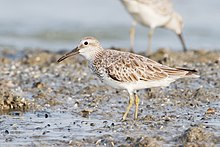Big Knutt
| Big Knutt | ||||||||
|---|---|---|---|---|---|---|---|---|

Big Knutt in a simple dress |
||||||||
| Systematics | ||||||||
|
||||||||
| Scientific name | ||||||||
| Calidris tenuirostris | ||||||||
| ( Horsfield , 1821) |
The great knot ( Calidris tenuirostris ), also called anadyrknutt , is a bird in the family of snipe birds . It is a breeding bird from Siberia , which is occasionally found as a random visitor in Western Europe and North America. No subspecies of the species are described.
features
Within the genus of sandpipers , the Great Knutt is the largest species with a body length of 28 centimeters. It is significantly larger than the Knutt and has a noticeably longer, thinner and more downward-pointing beak.
The top of the body is gray, the underside light with dark spots or stripes. In the splendid dress , the breast plumage is dark and there are dark, clearly defined spots on the flanks. Legs and beak are dark. The back plumage of the young birds is darker and lined with brown and white. From the red knot , the Great Knot distinguished by its size, the longer beak and the splendor of dress in which only a few of their feathers are brownish.
distribution
The species breeds as a ground breeder in the Siberian tundra , especially in northeastern Siberia . The clutch, which is located in a hollow in the floor, contains an average of four eggs. The Great Knutt is a migratory bird that overwinters predominantly in eastern India, on the coasts of the Malay Peninsula and especially in the north and west of Australia. A small population also overwinters on the southern coasts of the Persian Gulf and Arabian Sea . The wintering area extends from the United Arab Emirates, the east of Saudi Arabia, Oman to Pakistan and the north-west of India. In January 2000, hibernating birds were also observed for the first time on the coast of Iran. It is not known on which migratory route these birds enter the area. It is assumed that these knots either breed in the far west of the breeding area or come from an as yet unknown breeding area.
The Great Knutt is a real long-distance migrant, which is rarely observed inland during the migration and which covers long distances between the individual resting places. The females leave the breeding area in early July. The males and the young birds follow at the end of July. According to the current state of knowledge, their train route seems to lead them directly to the coast, from where they move south across the Sea of Okhotsk and the Sea of Japan along the coast of eastern China and the Philippines. Migrating Great Knutts can be seen in southeast Siberia and east China from late July to late October, with the main migration times falling in August and September. Adult birds arrive in Australia in late August and early September. This year's young birds usually arrive in Australia in October.
The Great Knutts leave their wintering quarters in northeast Australia from the end of March to mid-April. Presumably they fly from there directly without stopping to the rest areas on the coast of southern China. Great Knutts can be seen there from the beginning of April to the beginning of June. Great Knutts reach their breeding areas in northeast Siberia in the second half of May or at the beginning of June. Birds that have not yet completed their first year of life are very likely not to return to the breeding areas, but rather spend the summer in the tropical regions of their range.
habitat
The Great Knutt breeds in the subarctic highlands of northeast Siberia. The breeding areas are arctic-alpine regions, bare or stony mountain ridges in the interior at heights between 300 and 1,000 meters. The breeding grounds are characterized by large bare and gravelly areas overgrown with lichens and some herbs. In suitable areas, 13 breeding pairs were found on 9.5 square kilometers.
Outside of the breeding season, it hangs out on mud flats and sandbanks.
nutrition
Its food, which consists mainly of mussels and insects, is found mainly on beaches and in swamp areas.
Reproduction
The first breeding areas of this kind were not discovered until 1929, the breeding biology is still not fully explored.
The great knutt is a monogamous bird. They are territorial birds and both parent birds are involved in raising the young. However, it appears as if the females left the clutch before it hatched. So far only males have been observed leading young birds. The nest is a depression in the moss on an elevated and stony level. The clutch usually consists of four gray-yellow eggs with very intense red-brown spots.
Duration
The stock of the population is on the IUCN as "critically endangered" (endangered) listed. The bird is threatened by hunting and habitat loss in Korea and China , both countries that the Great Knutt passes through on its migration to the wintering areas. In Victoria , this type is called a "threatened" (endangered) listed. It is one of the species covered by the Agreement on the Conservation of African-Eurasian Migratory Waterbirds ( AEWA ).
literature
- Jonathan Alderfer (Ed.): Complete Birds of North America , National Geographic, Washington DC 2006, ISBN 0-7922-4175-4
- Peter Colston , Philip Burton: Limicolen - All European wader species, identifiers, flight images, biology, distribution. BlV Verlagsgesellschaft, Munich 1989, ISBN 3-405-13647-4
- Simon Delany, Derek Scott, Tim Dodman, David Stroud (Eds.): An Atlas of Wader Populations in Africa and Western Eurasia. Wetlands International , Wageningen 2009, ISBN 978-90-5882-047-1
Web links
- Calidris tenuirostris inthe IUCN 2013 Red List of Threatened Species . Listed by: BirdLife International, 2012. Retrieved January 14, 2014.

